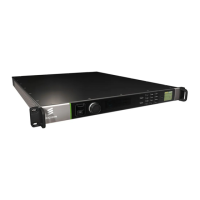12. Select the component just added.
13. Select Elementary Stream and assign an input to be handled as the
component.
14. Adjust PID or Bit rate weighting if necessary.
15. Move up to the Component List menu and repeat steps 9-12 to add more
components to the service.
16. Move up to the Service List menu and repeat steps 5-13 to add more services
to the Transport Stream.
17. After the Transport Stream has been created, move up to the Transport Stream
ID: 1 menu. Select the Change State option and set it to Online.
3.8.4 How to Add More Transport Streams
To add more Transport Streams to other outputs, follow the procedure detailed in
section 3.8.3 How to Set Up a Transport Stream by first selecting the Outputs
menu, then repeating the Transport Stream creation process. Alternatively, an
existing Transport Stream can be copied to another (or in case of IP output to the
same) output by proceeding as follows:
1. Select Outputs.
2. Navigate to the output to which a Transport Stream is to be added.
3. Select Add Existing Transport Stream.
4. Select the Transport Stream you want to copy.
5. The selected Transport Stream will be copied to the output.
6. Select the newly copied Transport Stream.
7. Select Change State and set it to Online.
3.9 How to Configure Video for EI9001 and EI9001T
3.9.1 AVP 4000 Video Input and Pre-Processing Parameters
Table 3.20 AVP 4000 Video Input and Pre-Processing Parameters
Parameter Optimum PSNR Setting Optimum Visual Setting
Adaptive Pre-Processing Filter OFF ON
The APF is especially useful in low bit rate
MPEG-2 encoding to prevent excessive
blocking, due to the lack of an in-loop deblocking
filter within the standard, unlike in H.264.
However, the APF may also benefit H.264
encoding at low bit rates

